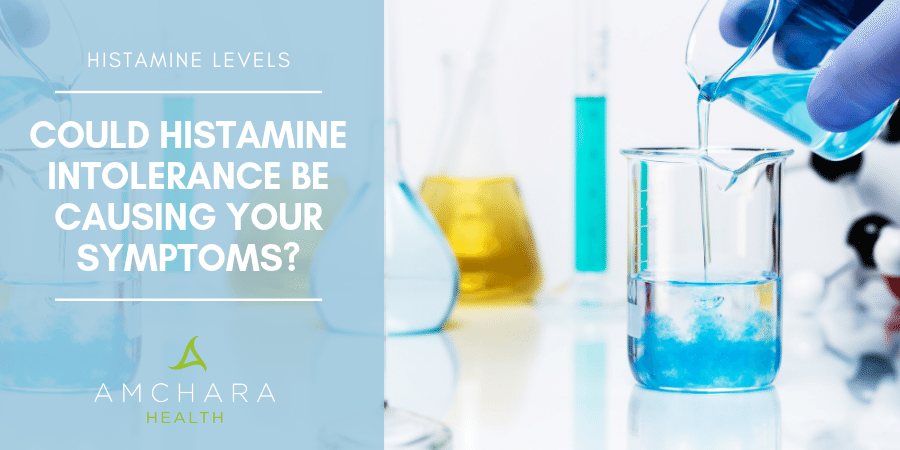Do you suffer from symptoms such as headaches, skin issues or digestive problems which appear out of nowhere and come and go without any obvious pattern?
If so, you may be suffering from a histamine intolerance.
In this article we’ll introduce you to histamine, why it’s produced and what can happen if it becomes unbalanced.
What is Histamine?
Perhaps the best known role of histamine is in connection with allergic reactions.
Histamine is produced by mast cells – special white blood cells in our immune system – in response to any substance perceived by the body as an invader.
This is part of our normal immune response.
Histamine acts as a signal to other white blood cells which are summoned to fight infection or repair damage.
It also causes blood vessels to dilate, so infection-fighting cells can rapidly find and remedy the problem.
The release of histamine causes symptoms such as sneezing, runny nose and skin rashes.
This inflammatory reaction is usually short-lived, because the histamine is rapidly broken down by enzymes ensuring levels don’t remain too high.
But histamine plays other important roles in the body too.
It’s involved in the communication process between brain cells and also causes the release of stomach acid to begin digestion.
As well as being produced by the body, histamine is also contained in some foods, while other foods enable the release of histamine in the body.
Histamine Clearance
The body produces two enzymes, DAO and HNMT, which break down histamine after it has done its job.
DAO is the enzyme which is primarily responsible for breaking down the histamine contained in the foods we eat, while HNMT is more concerned with breaking down the histamine inside our cells produced by the body.
If we don’t produce enough of these enzymes, histamine levels increase, the inflammatory reaction persists, and symptoms will continue.
High histamine levels can also be caused because the body is producing too much or taking in large amounts in food, meaning the enzymes responsible for breaking it down can’t keep pace.
Histamine Intolerance
Ongoing elevated levels of histamine are a feature of histamine intolerance.
Although this sounds as though the body has developed a sensitivity to histamine, the term is a little misleading as it is actually related to high histamine levels.
Effectively, it’s an imbalance between accumulated histamine and the body’s ability to break it down.
Histamine intolerance is estimated to affect at least 1% of the population (1).
Symptoms of excess histamine are very varied, and can include:
- Headache and migraine
- Flushing of the face and chest
- Hives, eczema and itchy skin
- Runny nose and congestion, sneezing
- Shortness of breath
- Itchy, runny eyes
- Fatigue and brain fog
- Anxiety
- Racing heart
- Nausea and vomiting
- IBS symptoms
- Menstrual irregularities, painful periods and hormone imbalance
- Sleeping problems
We have receptors for histamine all around the body which explains why excess histamine can cause so many different symptoms.
Histamine issues are often missed or misdiagnosed because of the huge range of possible symptoms, along with the fact they seem to come and go without any pattern.
Histamine intolerance is often confused with food allergy or sensitivities.
Causes of Histamine Intolerance
- Genetics
Some people are genetically susceptible to producing less DAO.
They possess a mutated gene which directs the activity of the enzyme.
Others have gene mutations which affect the HNMT gene.
- Gut Health
Increased intestinal permeability, otherwise known as leaky gut, can allow particles of incompletely digested food to access the bloodstream.
Because these are unfamiliar to the immune system in this form, they can stimulate an immune reaction and histamine release.
To make matters worse, inflammation of the intestinal lining can interfere with the release and activity of the DAO enzyme, so histamine is not broken down as rapidly.
If there is an imbalance in the microbiome, excess histamine can be the result.
Certain types of bacteria produce histamine (2), whereas others, such as the beneficial bacteria Bifidobacterium, suppress histamine release and may also decrease the sensitivity of receptors (3).
Research has found eating food low in fermentable fibres known as FODMAPs can reduce histamine levels (4).
When bacteria colonise the small intestine, in a condition known as small intestinal bacterial overgrowth (SIBO), histamine levels may increase.
It’s thought histamine plays a role in IBS, because researchers have noted almost 60% of people with IBS experience gastrointestinal symptoms after eating histamine-releasing foods.
The gut is home to 70% of the immune system, including large numbers of mast cells.
It’s thought mast cells in the large intestine secrete histamine causing abdominal pain in some IBS sufferers.
- Nutrient Deficiencies
Certain nutrients, in particular magnesium, manganese, zinc, copper and vitamins B6 and C are needed for DAO to function (5).
Selenium has also been found to reduce histamine release (6).
An inflamed gut, increased intestinal permeability or an imbalance in the microbiome can easily lead to reduced absorption of these nutrients.
- Medicines
Medicines such as nonsteroidal anti-inflammatory drugs (NSAIDs) can reduce the production of DAO, primarily because they cause inflammation of the intestinal lining.
Aspirin can encourage the release of histamine by mast cells (7).
Paradoxically, anti-histamine drugs which although they are taken with the purpose of reducing histamine and therefore alleviating allergy symptoms in the short term, can actually block DAO release when taken for long periods.
In any case, they don’t prevent the release of histamine, they simply prevent it from binding with receptors.
Other drugs which can significantly impact upon histamine levels by blocking DAO activity include antacids, high blood pressure medications and certain antibiotics.
- Stress
Chronic stress results in the release of hormones which stimulate mast cells to release histamine (8).
Histamine in Food
If your histamine levels are prone to rise, you may suffer symptoms after eating foods which naturally contain high levels of histamine.
The amount of histamine in foods varies, particularly depending on how long the food has been kept, and whether it has been refrigerated.
The following foods naturally contain high levels of histamine:
- Fermented foods including sauerkraut, vinegar and yoghurt
- Processed and smoked meats like bacon or salami
- Aged cheeses
- Shellfish
- Dried fruit
- Pineapple
- Avocado
- Aubergine
- Spinach
- Alcohol
Other foods, although they don’t contain high levels of histamine, can trigger its release, such as:
- Nuts, especially walnuts, cashews and peanuts
- Bananas
- Strawberries
- Citrus fruits
- Tomatoes
- Food additives, particularly colourings
Certain foods can block DAO production including alcohol, energy drinks, and black and green tea.
People who are intolerant to histamine often notice they don’t always experience symptoms every time they eat one of the foods on the above lists.
This is because sometimes symptoms only occur once histamine has reached a certain level in the body.
Often it’s the frequency a food is eaten or the combination of different histamine-containing foods that creates the problem.
How Do I Know if I Have Histamine Intolerance?
One way to find out is to avoid foods which elevate histamine levels for a short while and see how this affects your symptoms.
Genetic testing can look at the genes associated with DAO production and determine how efficient your body is in breaking down histamine.
Managing High Histamine Levels
We wouldn’t recommended avoiding high-histamine foods for any length of time because many of these foods are full of nutrients and so deserve a place in healthy food choices.
Avoiding these foods would mean eating becoming overly restrictive.
But the solution to histamine intolerance is not to simply avoid high-histamine foods.
A Personalised Health approach would examine why histamine levels are climbing too high and try to rectify the cause.
As we’ve seen above, histamine intolerance is closely linked to gut health.
A Personalised Health practitioner may recommend a stool test to determine if you suffer from leaky gut as well as examine the health of your microbiome.
Measures to manage histamine intolerance include:
- Look after your microbiome by choosing plenty of unprocessed plant-based foods containing natural fibre. Avoid sugar. Consider taking a probiotic supplement containing healthy bacteria.
- Curcumin, the active ingredient of turmeric has been found in studies to inhibit the activity of mast cells (9). Use turmeric in curries, stews, stir fries and even smoothies.
- The activity of our histamine-producing mast cells is closely connected with our sleep/wake cycle. Make sure you’re getting enough sleep with regular bedtimes and no blue light from screens in the evenings.
- Manage your stress – try deep breathing exercises, yoga or meditation.
- Avoid alcohol, which not only blocks histamine breakdown but also triggers its release.
Conclusion
Many people live with the unpleasant symptoms of histamine Intolerance for years because it is so often confused with other health issues.
If you suspect histamine intolerance may be behind your symptoms, a consultation with an Amchara Personalised Health practitioner can help to find the root cause of your symptoms.
We’re dedicated to providing you with both insightful information and evidence-based content, all orientated towards the Personalised Health approach.
We believe sharing knowledge and experience is an important part of achieving optimal health and would love to hear your views and experiences.
Do you suffer from histamine intolerance?
What strategies have you found useful for reducing your histamine?
READ THIS NEXT:




